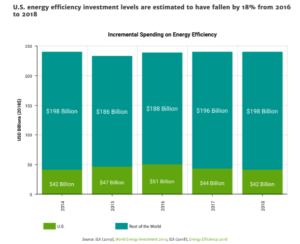Energy efficiency concepts and ideas have become second nature to the people of the United States since the early 1980s. In fact, if the U.S. had not started investing time and resources into efficiency measures in 1980, emissions would be 60% higher and consumers would be spending an additional $800 billion in energy costs than they are today.
No one can argue the benefits of energy efficiency. However, a recent report put together by the Alliance to Save Energy (ASE), The American Council for an Energy-Efficient Economy (ACEEE) and the Business Council for Sustainable Energy claims that “there are warning signs that suggest the commitment to energy efficiency is waning.”
The report points to the fact that Property Assessed Clean Energy (PACE) investment saw a steady increase from 2012 to 2017 but noticed the trend start to level out and even decrease more recently. PACE measures financing for efficiency and renewable projects on private property domestically. Additionally, investments implemented by Energy Service Companies (ESCOs) domestically have plateaued and fallen by 18% from 2016 to 2018, as depicted in below bar chart.

ACEEE Senior Policy Advisor Lowell Ungar believes that maximizing the investment potential in efficiency projects throughout the U.S. has the ability to achieve “half the savings needed in order to end greenhouse gas emissions by mid-century, but that requires a huge investment and commitment.”
To discuss how a slowing in efficiency projects could impact policy and pricing down the road, contact your Atlas Energy advisor.
Learn more about our services or how to become an energy broker today. Just fill out the form below and someone will contact you within 1 business day.

